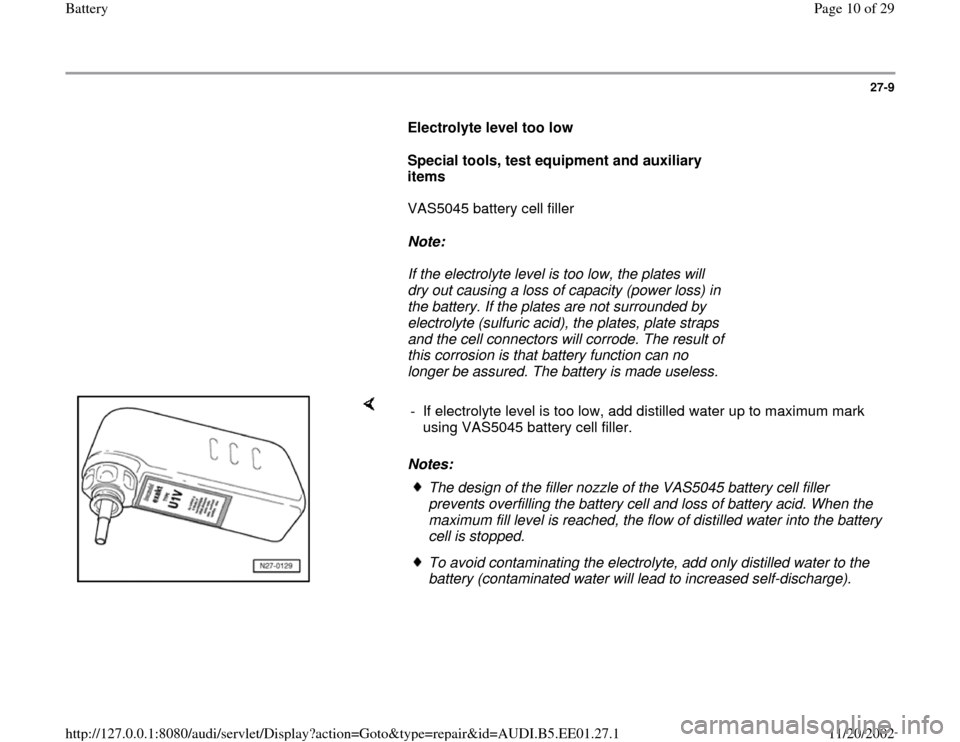Page 10 of 29

27-9
Electrolyte level too low
Special tools, test equipment and auxiliary
items
VAS5045 battery cell filler
Note:
If the electrolyte level is too low, the plates will
dry out causing a loss of capacity (power loss) in
the battery. If the plates are not surrounded by
electrolyte (sulfuric acid), the plates, plate straps
and the cell connectors will corrode. The result of
this corrosion is that battery function can no
longer be assured. The battery is made useless.
Notes: - If electrolyte level is too low, add distilled water up to maximum mark
using VAS5045 battery cell filler.
The design of the filler nozzle of the VAS5045 battery cell filler
prevents overfilling the battery cell and loss of battery acid. When the
maximum fill level is reached, the flow of distilled water into the battery
cell is stopped. To avoid contaminating the electrolyte, add only distilled water to the
battery (contaminated water will lead to increased self-discharge).
Pa
ge 10 of 29 Batter
y
11/20/2002 htt
p://127.0.0.1:8080/audi/servlet/Dis
play?action=Goto&t
yp
e=re
pair&id=AUDI.B5.EE01.27.1
Page 11 of 29
27-10
Electrolyte level too high
Special tools, test equipment and auxiliary
items
Commercially available hydrometer
Note:
If the electrolyte level is too high, the sulfuric acid/water mixture will leak
to the outside of the battery and damage functional components in the
engine compartment.
- If electrolyte level is too high (overfilling), i.e., it is above internal
electrolyte level mark (lip of plastic flange) or external maximum line,
draw off excess electrolyte using commercially available hydrometer.
- Draw off electrolyte using hydrometer until electrolyte level has
reached lip of plastic flange or maximum line.
Pa
ge 11 of 29 Batter
y
11/20/2002 htt
p://127.0.0.1:8080/audi/servlet/Dis
play?action=Goto&t
yp
e=re
pair&id=AUDI.B5.EE01.27.1
Page 13 of 29
27-12
No-load voltage, checking
CAUTION!
Battery cell caps must be screwed in tightly
when charging, measuring voltage or
performing load tests.
Always comply with the following
instructions otherwise a correct
measurement cannot be assured.
Special tools, test equipment and auxiliary
items
VAG1715 multimeter or
VAG1362 minitester or
Multimeter (Fluke 83 or equivalent)
Notes:
When testing the no-load voltage of a battery
installed in a vehicle, make sure the battery
Ground (GND) strap is disconnected.
The battery must not have been under a load
Pa
ge 13 of 29 Batter
y
11/20/2002 htt
p://127.0.0.1:8080/audi/servlet/Dis
play?action=Goto&t
yp
e=re
pair&id=AUDI.B5.EE01.27.1
Page 16 of 29
27-14
Specific gravity, checking
Special tools, test equipment and auxiliary
items
CAUTION!
Notes:
The specific gravity can be tested immediately after charging the battery.
Commercially available hydrometerShop towelWhen working with battery acid, make sure to follow all "Warnings
and safety precautions for lead-acid batteries." Wear suitable
protective clothing and eye protection. When disposing of batteries, always comply with applicable
Federal, State and local laws regarding the disposal of batteries
and sulfuric acid. In order to better determine the overall condition of a battery, always
perform a specific gravity test in conjunction with the load test. The temperature of the electrolyte must be at least 10 C (50 F).
Pa
ge 16 of 29 Batter
y
11/20/2002 htt
p://127.0.0.1:8080/audi/servlet/Dis
play?action=Goto&t
yp
e=re
pair&id=AUDI.B5.EE01.27.1
Page 21 of 29
27-18
Load testing
In order to better determine the overall
condition of a battery, always perform a load
test in conjunction with the specific gravity
test.
Special tools, test equipment and auxiliary
items
Note:
When using the VAS1979 or VAS5033 battery tester, it is not necessary
to remove the battery or disconnect the battery cables.
VAS1979 or VAS5033 battery tester
- Follow warnings and safety precautions for lead-acid batteries. Wear
protective clothing such as face shield and leather gloves.
Pa
ge 21 of 29 Batter
y
11/20/2002 htt
p://127.0.0.1:8080/audi/servlet/Dis
play?action=Goto&t
yp
e=re
pair&id=AUDI.B5.EE01.27.1
Page 24 of 29
27-21
Battery, charging
CAUTION!
Battery cell caps must be screwed in tightly
when charging, measuring voltage or
performing load tests.
Do not enter the room in which batteries are
being charged with unenclosed light bulbs or
when smoking. The reason for this is that an
explosive gas is formed in the battery by the
charging process.
Special tools, test equipment and auxiliary
items
Battery charger
Batteries should be charged using a VAG
battery charger such as VAG1471, VAG1648 or
VAS1974.
Notes:
The temperature of the battery must not be less
than 10 C (50 F).
Batteries should not be fast-charged; fast-
Pa
ge 24 of 29 Batter
y
11/20/2002 htt
p://127.0.0.1:8080/audi/servlet/Dis
play?action=Goto&t
yp
e=re
pair&id=AUDI.B5.EE01.27.1